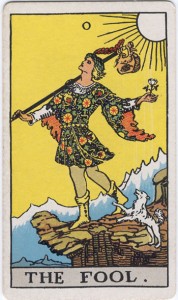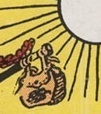Podcast: Play in new window | Download
Our journey begins with the Fool, a trickster, the one who disrupts our complacency and calls us out of ourselves to a world of joy and liberation. Court jesters always had special dispensation to say whatever they wanted, even if it was irreverent and disrespectful. In fact the Fool was expected to be irreverent and disrespectful. That was his role.
The Fool is also a pain to have around, never letting us rest, always trying to stir us up. Yet the Fool always knows when to stop; he is benign and if he harms us, it is only for our own good. He annoys but never destroys us.
But God hath chosen the foolish things of the world to confound the wise
And God hath chosen the weak things of the world to confound the things which are mighty;
And base things of the world,
And things which are despised, hath God chosen,
Yea, and things which are not,
To bring to nought things that are
The Image
As we look at the card, we see the figure of the Fool centred in the picture, up and down the middle, with his arms extended almost to the frame. He enacts the figure of a cross, but not quite. His body is arched, his arms are gracefully bent, his wrists delicately curved. His right hand lightly balances the staff on his shoulder; his left hand delicately holds the rose between thumb and forefinger. His weight is on his left leg. He is dancing, carefree, open to the world.
He is gazing off into the heavens, not looking where he is going, even though he is about to walk off a crumbling cliff-face. He seems to be holding his position as lightly as he is holding the staff and the rose.
The sun, symbol of conscious, rational, divine guidance, is behind him. He has turned from the Light and with the sun behind him, must be walking into his Shadow, his unconscious, irrational self. Moving to the left confirms that this is a journey into the unconscious. No wonder he is not concerned about where he is going. All he knows is that he is headed into the unknown.
But this journey into the unknown shadows, off the cliff, is also divinely sanctioned. The staff on his shoulder points to the sun at one end, and the other end points off the card down to the left, connecting indirectly the consciousness of the sun with the unconsciousness of the shadow. His aim is to bring light to these regions.
He has nowhere to go but down. He has been in the heights, and now heads for the depths. The mountains in the distance echo this downward movement, as they also remind us, with their wave-like shapes, that there will be peaks even in this descent.
Is his expression hopeful? Serene? Or just foolish? What do we expect from a Fool?
Is this the face and figure of a man, though? Or a woman? Although the clothes are men’s clothes, the face is sexually ambivalent, androgynous, a unification of the male and female energies, yin and yang, balanced at the start of this journey.
The clothes seem too ornate and showy for a journey – unless that journey is also a celebration. The pattern on the cloth presents patterns of stars within circles, flowers and leaves in subtle arabesques. The belt is composed of circles too – repetitions of the number zero. The sleeves are flowing, wave-like at the edges. Next to his skin he wears a white tunic – the purity and innocence beneath all his show, the colour of the divine sun next to his skin.
Is that a laurel wreath around his temples? That is certainly a feather floating up from above his brow, a kind of wavy antenna in touch with the sun, interrupting and absorbing the ray of the sun.
His scrip or wallet hangs on the end of his stick suggesting those little boys who run away from home, or those tramps who have no home. All his belongings are contained in this small bag. His needs are few. Or the scrip might contain all his accumulated experiences, which he keeps behind him, but still retains, ready for use if he needs them. The scrip, and the tip of the staff also interrupt the sun’s rays and absorb the blessing and power of the Light.
The rose too is behind him, held at a distance. It seems a little like a temptation that the Fool turns away from, perhaps with some reluctance. Maybe, white like the sun, the rose too must be put behind him. Such beauty may be a distraction from the aims and dangers of the journey. And yet the rose is not entirely put aside; its colour is repeated in the tunic, next to the Fool’s body. From the Sun, to the Rose, to the Body.
Next to the Fool is the dog, jumping up on its back legs, imitating the precarious position of its master. Is the dog playing (it almost looks like a smile on its face), or is it giving a warning? Or, manifesting the restless eagerness to move onward that this card has been suggesting, is the dog nipping at the Fool’s heels to urge him to get going? In any case, the dog is white, a significant colour on this card. Not only does the Fool have the white rose in his fingers and the white tunic next to his body, but he is accompanied by the white dog at his feet. Even if he is unconscious of where he is walking, his steps are accompanied by the divine light of consciousness; wherever he steps will be fortunate.
And finally, the number on this card: zero, nothing. With nothing in front of him and his past packed up behind him, the Fool journeys as “unaccommodated man”, with no preconceptions, open to whatever comes. This is the point of kenosis, that emptiness at which any real mystical experience can begin.
This Fool, signified by the number zero, is a nobody, but in all myths, it is the one who is overlooked, who is dismissed as insignificant, who succeeds in the trial. To start this journey we must refuse to conform and not expect praise, which is worthless to us now.
I’m Nobody! Who are you?
Are you—Nobody—Too?
Then there’s a pair of us!
Don’t tell! they’d advertise—you know!
How dreary—to be—Somebody!
How public—like a Frog—
To tell one’s name—the livelong June—
To an admiring Bog!
Here then is our Fool, the image of joyful, foolish risk-taking. Risks will not always succeed; success is never guaranteed. But in this image we see all indications pointing to the ultimate good fortune of the venture: the sun, staff, mountains, all indicating that though we go downwards, we go blessed.






[…] And take a look at our podcast on the Tarot Fool. […]